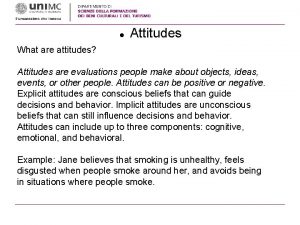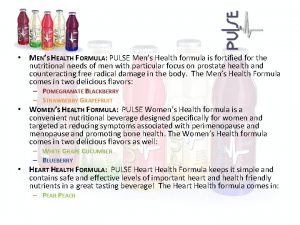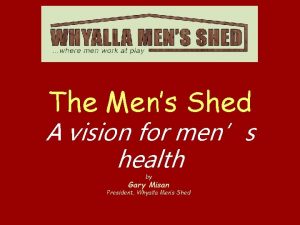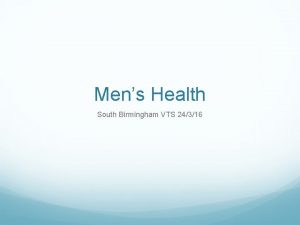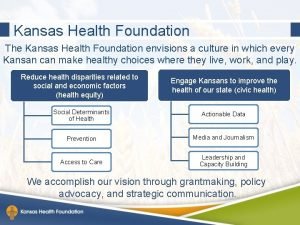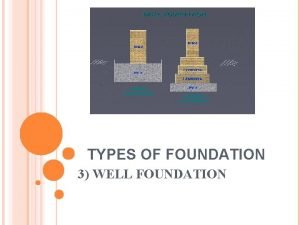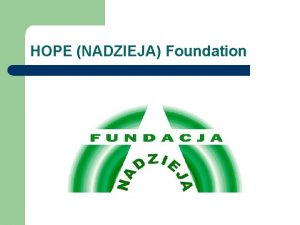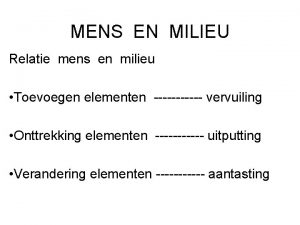FREEMASONS FOUNDATION CENTRE FOR MENS HEALTH Mens Attitudes


































- Slides: 34

FREEMASONS FOUNDATION CENTRE FOR MEN’S HEALTH Men’s Attitudes and Behaviours Towards Health Research PRESENTATION OF FINDINGS 15 OCTOBER 2010 PRESENTED BY HELEN FISCHER

Methodology Overview § Sampling method was non-replacement - provides the rigor required for this type of study and used in SA Health’s population health studies. § A sample of 4, 900 numbers was used, achieving a response rate of 49. 8%. § Primary Approach Letters were sent to the selected addresses, advising them that they may be contacted and encouraging their participation. § Pilot test of 25 surveys - check general flow of the questionnaire and that questions ‘worked’. This pilot was included in the final sample of 1, 506 completed surveys (prior to weightings by age being applied). § Numerous call backs were made - more than 10 (average) to achieve final sample. § Raw sample stratified by age only and subsequently weighted to correspond with the population distributions in ABS 2006 Census Data.

Research Objectives § Market analysis - test concept of demonstration men’s health service as a critical step in informing business planning. § Key objectives to explore: ~Men’s help seeking behaviour, the triggers and barriers associated with decision making process. ~Reaction to concept of a dedicated men’s health service. ~Segments most attracted to this service concept. ~Factors which would motivate men to use such a service. ~Key service characteristics important to men. ~Would they be willing to pay for it. § These issues, and subsequent development of the survey instrument, were initially informed through qualitative discussions with men across a range of ages. § Revealed a well defined need for a dedicated men’s health centre with a strong focus on comprehensive assessment alongside a health management plan.

SEGMENTATION

Segmentation “I am not aware of my health risk factors and I am not bothered by this”. “I am not aware of my own health risks, but I do care about this aspect of my health”. “I am somewhat aware of my own health risks, but should probably know more”. “Yes, I understand my own health risks very well”. NOTE: 5% of 18 -24 year olds represents 49% of Segment 1, (i. e. 11 / 23 men).

Segmentation § Broadly, primary target group of men aged between approximately 35 and 54 years, identified in the exploratory phase, has been confirmed. § Based on overall pattern, taking into account a combination of: ~ the findings of the segmentation study, ~ the reported attitudes towards help-seeking and managing health risks, ~ the appeal of the men’s health service / comprehensive health check among this age cohort, and ~ their willingness to pay more for the health check (placing greater value on service). § Whilst 25 to 34 year olds showed a high statistical significance of classifying themselves as Segment 3, this age group were also; ~ less likely to find the concepts of men’s health service / comprehensive health check appealing, ~ less willing to pay for the health check and, ~ less likely to self-manage their health risks. § Pattern more consistent with Segment 2, making them a secondary target segment.

MEN’S HELP SEEKING BEHAVIOUR

Current health help seeking Main reasons visited doctor / specialist in the last year (90% of men, n=1, 347) were: ~ Seek treatment for acute illness – 35%, ~ General health check-up – 29%, ~ Seek advice / treatment for chronic disease – 27%, ~ Renew a script – 22%, and ~ Seek help for an injury – 17%. Age, marital status, attitudinal segment, frequency of doctors visits and employment status all impacted significantly on the main reasons for visiting a doctor or specialist. Older men (55+) - more likely to have requested general check up, help with chronic disease and cancer VERSUS 25 -44 year olds - acute illness, medical certificate or injury. Regional men – injury, medical certificate VERSUS metropolitan men acute illness. Divorced / widowers – chronic disease, renew script, general health check or help for mental health problem. However, tended to be 55 years+, no direct evidence to suggest marital status has impacted on health outcomes.

Current health help seeking § In general, men tend to adopt a “wait & see” approach, until about age 55, when lifestyle and other factors compel action. Men in peak working / family life -stages sig. more likely to wait until symptoms become unbearable or prevent them working before seeking doctor. Tendency to not be proactive in seeking help. 2 in 3 men said there is zero likelihood they would call telephone help-line or call centre for health advice.

Patterns of men’s help seeking behaviour Relationship exists between frequency of visits to a doctor / specialist and incidence of visiting an allied health professional. Those who reported 10+ visits to GP also showed high incidence of visiting allied health professionals except chiropractor (stat. sig. @ 95% CL). Self-monitoring behaviour § More likely to talk to their spouse / partner / girlfriend about their symptoms than make an appointment with their doctor right away (68% versus 51% respectively). More prevalent among men 25 to 54 years. § Slightly more likely (56%) to monitor their symptoms in the hope they would go away rather than visit a doctor right away. § Half men surveyed (49%) would try to self-diagnose. § Two in five (44%) would wait until the symptoms became unbearable or prevented them from working or functioning before making an appointment with their doctor.

Delay / avoiding seeking help 7 out of 10 men (72%) delay or avoid seeking help from a health professional to address their health concerns. Most prevalent between the ages of 25 and 44 years, but included men from 18 to 64 years. The primary reasons put forward by these men were: Delay until symptoms affect capacity to work / function (51% agreed) Assume the problem will fix itself (50% agreed) Too busy with other priorities (48% agreed) More important to look after loved ones than self (33% agreed) Don’t like to admit something is wrong (21% agreed) Assume there is nothing the doctor can do (21% agreed).

HEALTH STATUS

Health status 7 out of 10 men (70%) had concerns about their health. The two most commonly raised concerns were: weight / being overweight (12%) concerns about cancer (11%). Men classified as Segment 3, showed a high incidence of stating that “being overweight was of concern to them” (more than one in seven, 15%). Suggests that a weight loss / weight control component would appeal to the men most likely to attend men’s health service (approx. 30 to 50 year olds). Further supporting a Profile of men most likely to have concerns aboutfocus weight on: weight loss, Married, more than half of all men surveyed had either Under 55 years attempted to lose weight Professional or sales / clerical role H/hold income in the mid-range ($75 -100, 000) in the last year or thought about doing so.

Motivation to improve health Almost half of men surveyed indicated they were motivated to change their health risk factors but either: ~ “can’t seem to take action” (40%) or ~ “don’t know where to go or what to do” to help themselves (8%). The primary driver of motivation to improve their health was “Having more energy and generally feeling better” (three in four men). Having said this, nearly nine out of ten men felt they have the resources and support they need to improve their health and make changes to their lifestyle. Profile of those who felt they did not have the resources and support needed included: 45 to 54 year olds, manager / administrator occupations, those with a higher likelihood of attending the men’s health service and using the comprehensive health check. These findings support the hypothesis that there is need for a men’s health service as proposed, particularly among the men profiled as the primary target group.

CURRENT MEDICAL SERVICES

Key attributes of medical practice Key attributes of their current medical practice driving satisfaction were: convenience to home, 8 / 10 men satisfied their doctor aware of men’s health issues. awareness of men’s health issues suitability of opening times, reasonable cost, sufficient time to discuss their concerns, a holistic approach, comfortable waiting area, and availability of their own doctor. They were least satisfied with the availability of information / reading material pertinent to men’s health (28% dissatisfied with this aspect). This presents an opportunity for the proposed men’s health service to increase men’s knowledge of gender-specific health issues. One in five men were dissatisfied that the waiting time (after appointed time) was reasonable – a key factor in qualitative study.

Key attributes of medical practice Segments 2 and 3 (“unaware but open”, and “aware, need more information / support”) were significantly less satisfied with: ~ Waiting times being reasonable, ~ enough time to discuss their health concerns (not just symptomfocused), ~ suitable opening times and, ~ their doctor having awareness of men’s health issues. all showed statistically lower satisfaction among these two segments. These two groups tended to profile as 34 to 54 years of age and employed. Provides some clues as to which attributes of a men’s health centre might be appealing to the primary target group. Men more likely to attend a men’s health centre showed lower levels of satisfaction across most attributes of their current medical practice. Profiled as young and middle family life-stages, so within the same age sub-groups as Segments 2 and 3.

Important attributes for doctor / GP § As would be expected, attributes along the lines of listening and responding, taking appropriate time with patient, establishing a rapport and awareness / understanding of men’s health issues were all very important to these men. § Age was not important to the majority of men. Importance increased exponentially with age of men surveyed. § Gender also not important to majority (62% said either), although one in four generally prefer a male doctor (mostly 55 plus) and prefer male doctor when dealing with sensitive issues (11%), particularly among 18 to 24 year olds (19%). § Among the primary target group (i. e. 25 -54, young / middle family lifestage) gender was only important when dealing with sensitive / personal issues. § Two in every three men said they had no problem discussing any issue with their usual doctor. § However, one in three do have some issues with this: ~ 30% said this is awkward but they can do it anyway, ~ 3% were not comfortable and would seek another service. § Findings imply there is a market for a men’s health centre with focus on sensitive / personal health issues. § Represents opportunity to promote the men’s health service as being confidential and specialised, alongside focus on chronic health management / prevention and weight loss / weight management.

APPEAL OF CONCEPTS

Appeal of men’s health service § Six out of ten men (59%) said they would be likely to use dedicated men’s health service. § Higher likelihood among men aged 25 to 54 years, Segment 3’s, and men in managerial or trade / labour occupations. § Biggest barrier to attendance was a preference for own doctor, more likely raised by 55 plus year olds. Modelling of likelihood – standard research technique.

Appeal of comprehensive health check § Nearly eight out of ten men (77%) said they would be likely to use comprehensive health check. § Again higher likelihood among men aged 25 to 54 years / Segment 3’s and men in managerial or clerical / sales occupations. § Biggest barrier to using this service was again satisfaction with service provided by own doctor, raised by 37% of men unlikely to use service (9% of all men). Modelling of likelihood – standard research technique.

Likelihood of attending men’s health service – specific health issue § Those who had visited doctor in last year, asked to indicate likelihood of attending men’s health service for treatment of the specific health issues they sought help for from GP. § Represents 90% of sample. § Likelihood fell to 38%. § Particularly low for 55 years plus. § Not linked to a specific health issue, so visits could have been for medical certificate, acute illness or injury, for example.

CRITICAL ELEMENTS

Critical elements of men’s health service Critical attributes important to these men tended to focus on the more esoteric aspects such as holistic, competence, proactive, rather than the practical elements such as flexible and longer appointments or opening hours. § However, all elements of a men’s health service, and in particular the practical ones, took on greater importance to those likely to attend a men’s health service and to those likely to use a comprehensive health check.

Location of men’s health service § Location poses some dilemmas, given that: ~ “location close to home” is a driver of satisfaction, and ~ the proportion willing to travel 45 minutes or more to get a quality men’s health service is relatively low (18%). § Majority of men surveyed were willing to travel about 15 to 30 minutes (55%). § Proportion higher among the primary target groups of 35 to 44 year olds, employed men and those living in the metropolitan area. § When asked about travel if the men’s health service was located in Adelaide, 47% said this would make them less willing to attend versus 53% stating it would either make no difference or make them more willing to attend. § Given the confidence interval of ± 2. 5%, this results in men being slightly more favourable towards location in Adelaide than against, but it is not conclusive.

Price sensitivity § Price sensitivity revealed disparity in perceptions of the value of the comprehensive health check: ~ Slight majority (52%) thought the price should be below $100 for the health check, ~ only one in seven men thought the price should be $100 or more, ~ a further third of men perceived the cost should be covered under Medicare or they could not suggest a dollar value. § Among those likely to use the comprehensive health check, however, a slightly higher monetary value was placed on this service (high proportion stating $100 to $149 and $200 or more). § These findings support the estimate of between $100 and $150 suggested in the exploratory phase of this research.

Clear relationship between high likelihood of undertaking comprehensive health check and higher value placed on this service. Research links § No resistance to the proposed men’s health service having close links to research. § Proviso - made clear that the men are not obliged to take part in any trials unwillingly or, in their words, be treated as a “guinea pig”.

RECOMMENDATIONS

RECOMMENDATION ONE: § Research confirmed primary target cohort of around 35 to 54 years, middle to mature family life-stages, for both a men’s health service and comprehensive health check. § Secondary cohort, 25 to 34 years, young family life-stage, tend to put their own health as a low priority with work and family taking precedence. This sub-group represents an opportunity to engage with this segment to create generational change in men’s help-seeking behaviours. § Men aged 55 years and older were least likely (alongside 18 to 24 year olds) to be interested in the concepts. Given statistical confirmation of the primary target group, as outlined in the exploratory research, it is recommended that the needs of this segment should be prominent in the strategic development of the concept to the next level.

RECOMMENDATION TWO: § The research also provides evidence of a need for a dedicated men’s health service incorporating a comprehensive health check. § Numerous indicators support the assertion that such a service would be utilised by men, particularly in the primary target cohort. § Conservatively, between one in five and one in four men aged between about 35 to 54 have indicated an intention to use such a service, if it were available. It is recommended that the Foundation pursue its goal of developing the men’s health service with a health risk assessment as the centrepiece and appropriate follow-up to address men’s health issues from a holistic point of view.

RECOMMENDATION THREE: § Almost half of all men surveyed said they had attempted to lose weight in last year. § Being overweight is a primary concern affecting men, especially when managing their health risks. § The peak age for having attempted to lose weight revealed that 35 to 64 year olds were significantly more likely to have attempted weight loss in the last year. § The same cohort identified as the primary target group for a men’s health centre with a special focus on managing health risks which lead to chronic disease. It is recommended that the focus in the early development of the men’s health service should be on weight loss and weight management, a strategy which would achieve two primary goals, supporting weight loss proactively and encouraging greater focus on health risk management.

RECOMMENDATION FOUR: § The research also provides evidence of a need for a dedicated men’s health service incorporating a comprehensive health check. § Numerous indicators support the assertion that such a service would be utilised by men, particularly in the primary target cohort. § Conservatively, between one in five and one in four men aged between about 35 to 54 have indicated an intention to use such a. Itservice, if it were is recommended thatavailable. the Foundation pursue its goal of developing the men’s health service with a health risk assessment as the centrepiece and appropriate follow-up to address men’s health issues from a holistic point of view.

RECOMMENDATION FIVE: § It is acknowledged that focus on sexual dysfunction would provide a valuable health service to men and fill the reported unmet need for treatment existing in primary health care setting. § However, the men surveyed did not acknowledge that seeking help with sexual dysfunction was a significant problem for them. § They also indicated they had no difficulty in talking to their own doctor about personal or sensitive topics. § Anecdotally, the men in the group discussions indicated they would be more willing to contact an anonymous telephone number than they would be willing to spontaneously raise sexual dysfunction with their doctor. It is recommended that the focus of communications, at least in the early stages, avoids concentrating on sensitive health issues such as sexual dysfunction. Until (or if) men acknowledge, and proactively seek help for, this type of health issue, personal topics appear to be a “no go area” rather than an opportunity.

Powerful motivation for men across all ages: “What will happen if I’m not in control? ” THANK YOU
 Masonic leadership
Masonic leadership Pad foundation section
Pad foundation section Composition of urine
Composition of urine European foundation centre
European foundation centre Centroid in engineering mechanics
Centroid in engineering mechanics Difference between centre of gravity and centroid
Difference between centre of gravity and centroid Kontinuitetshantering i praktiken
Kontinuitetshantering i praktiken Novell typiska drag
Novell typiska drag Nationell inriktning för artificiell intelligens
Nationell inriktning för artificiell intelligens Returpilarna
Returpilarna Varför kallas perioden 1918-1939 för mellankrigstiden?
Varför kallas perioden 1918-1939 för mellankrigstiden? En lathund för arbete med kontinuitetshantering
En lathund för arbete med kontinuitetshantering Underlag för särskild löneskatt på pensionskostnader
Underlag för särskild löneskatt på pensionskostnader Tidbok för yrkesförare
Tidbok för yrkesförare Anatomi organ reproduksi
Anatomi organ reproduksi Förklara densitet för barn
Förklara densitet för barn Datorkunskap för nybörjare
Datorkunskap för nybörjare Tack för att ni lyssnade bild
Tack för att ni lyssnade bild Hur skriver man en debattartikel
Hur skriver man en debattartikel Magnetsjukhus
Magnetsjukhus Nyckelkompetenser för livslångt lärande
Nyckelkompetenser för livslångt lärande Påbyggnader för flakfordon
Påbyggnader för flakfordon Lufttryck formel
Lufttryck formel Publik sektor
Publik sektor Jag har nigit för nymånens skära text
Jag har nigit för nymånens skära text Presentera för publik crossboss
Presentera för publik crossboss Argument för teckenspråk som minoritetsspråk
Argument för teckenspråk som minoritetsspråk Bat mitza
Bat mitza Treserva lathund
Treserva lathund Luftstrupen för medicinare
Luftstrupen för medicinare Claes martinsson
Claes martinsson Cks
Cks Lågenergihus nyproduktion
Lågenergihus nyproduktion Mat för idrottare
Mat för idrottare Verktyg för automatisering av utbetalningar
Verktyg för automatisering av utbetalningar









































